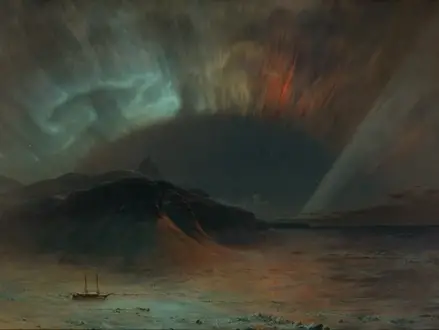Title of Artwork: “Aurora Borealis”

Artwork by Frederic Edwin Church
Year Created 1865
Summary of Aurora Borealis
Arctic wastelands are shown in this picture by the Aurora Borealis or Northern Lights. It is clear that Church had a gift for establishing formal approaches that properly conveyed complicated and nuanced meteorological phenomena, as seen by the dancing light in the sky. Blue, yellow, and red hues flood over the sky while a definite yet wavy line is etched across it.
All About Aurora Borealis
Church’s buddy, the explorer Isaac Israel Hayes, made a trip to the Arctic in 1867 and wrote about it in The Open Polar Sea, which was published in 1867. His written narration and illustrations gave Church with the information he needed to write about the events he saw. An evocative rather than precise replication” of any particular scene, the artwork recreates Hayes’s storey and drawings, according to critic John K. Howat. Hayes’s little boat in the left foreground has been erroneously referred to be his vessel, although he was never stranded in ice. Friendship and scientific cooperation are evident in Church’s use of Hayes’s material for his own creative endeavours. This painting served as a public relations tool for Hayes, as well as a means of promoting Church’s own work.
In the words of experts like as Jennifer Raab, Church’s concern in depicting atmospheric and light events with scientific precision can be seen in images like Aurora Borealis. This technical integrity was matched with an uncanny sense of rhapsodic mood, which is evident in his work. A wide variety of modern opinions on Aurora Borealis’ subject matter may therefore be understood as bringing together both the pioneering scientific spirit and the awe-seeking Romantic sensitivities of its time.
Information Citations
En.wikipedia.org, https://en.wikipedia.org/.
























